|
****JavaScript based drop down DHTML menu generated by NavStudio. (OpenCube Inc. - http://www.opencube.com)****

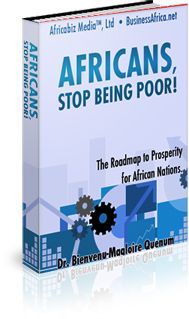
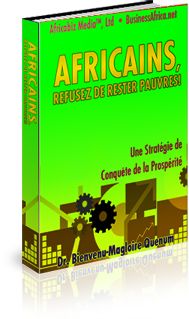
|
|
!
|
|
AFRICABIZ
VOL 1 - ISSUE: 43
NOVEMBER
15 - DECEMBER 14, 2002
Previous
Issue
Editor: Dr. Bienvenu-Magloire
Quenum
Click here for contact & support console
|
| A
WORD FROM THE EDITOR
|
|
|
|
Dear visitor and international investor,
We
warmly welcome you, if this is
your first visit to Africabiz
Online - The ultimate newsletter
on trading and investing in 49
sub-Saharan African countries.
If you are a regular and faithful
reader, welcome back.
If you are a regular and faithful reader, welcome back.
-
THE COLLAPSE
OF IVORY COST / AN EXAMPLE OF DEVASTATING CONSEQUENCES
TRIGGERED BY MISLEADING CONCEPTS AND BAD MANAGEMENT
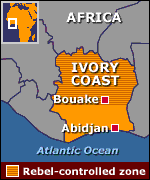 Since
September 19, 2002, the political situation - and
therefore the state of the economy, worsened in Ivory
Coast. Rebels engineered a military upheaval and challenged
government troops. Since
September 19, 2002, the political situation - and
therefore the state of the economy, worsened in Ivory
Coast. Rebels engineered a military upheaval and challenged
government troops.
They succeeded in 15-day blitz
campaign to split the country (as shown on the map
at left side of the page) into two equal and separate
territories.
The northern part from the city of Bouake
upward under rebels' control. The southern part, downward
from the city of Bouake under government's control. Click
here for Ivory Coast's Country Briefs.
A cease-fire agreement
signed on October 17, 2002 froze the battle lines. Negotiations
started on October 30, 2002, under the sponsorship of
the Economic Community of West Africa States (ECOWAS),
at Lome / Togo,
led and supervised by Togo's President / General Eyadema,
and attended by Ivory Coast's government representatives
and a delegation of the rebels
At the time of posting current issue, on November 15,
2002, no one can predict for sure the outcome - peace
agreement and stability or resumption of fighting and
chaos.
Indeed, conditions and requests laid down by the rebels
i.e. resignation of President Gbagbo, modification
of the country's controversial Constitution, which
bans some Ivorian citizens from running for presidential
position, and the immediate scheduling of a new presidential
ballot in advance to the normal deadline of year 2005,
are rejected by the government.
On the other side,
the demands by the government that rebels unilaterally
give up fighting and disarm are categorically rejected
by the insurgents. It will be difficult for both parties
to reach a compromise.
Furthermore, several murders, in Abidjan, of key opposition's
members and sympathizers, the assassination of rebels
leaders' relatives, kidnapped by mysterious death
squads, are signs that everyone in the government
circle and or the rebels' side is not in favor of
negotiation.
In addition, taking advantage of the cease-fire,
the warring parties are preparing for the "final"
show down. They are purchasing gunships / copters,
tanks, motor vehicles, weapons against warplanes and
ammunitions.
All that money squandered into buying military equipment
is lost for financing the development of the economy
to creating riches for all.
As we all know, nothing in human life happens on the
sudden. Diseases, crucial political events, victories
in sports competitions, wars, and divorces, etc.;
every occurrence under the sun has hidden history and
long lasting causes.
The history and hidden causes behind the collapse of
Ivory Coast are closely linked to the adoption ten years
ago, in 1993, and subsequent implementation of a nationalistic
concept named Ivoirité.
That concept denies full citizenship to Ivorian
whose parents are not both "pure"
Ivorian.
The reckless implementation of the Ivoirité concept,
by successive Ivorian governments of Bedie, Guei and
Gbagbo, since 1993, led to the harassment of northerners
who have to go through all kinds of hurdles and humiliation
to get ID cards. Without ID cards they are denied
voting rights.
Furthermore they are removed from
key positions in the army and the administration.
So, what happens when people feel cornered did happened.
The northerners Mohammedans took to arms on September
19, 2002, to defend their dignity and own back their
citizenship.
The Ivoirité concept is a vivid example of
the damage and chaos a badly conceived dogma or strategy
can trigger.
The politicians who devised the Ivoirité concept
failed to do the right brain storming and thinking.
They abandon a winning
political strategy established by the founding father,
President Houphouet Boigny.
They simply mismanaged
the heritage left by Houphouet Boigny. They have
not fully analyzed the resulting consequences of their
decision in relation with, first, the historyof
the country and, second, the social and ethnic composition
of its population.
In order to get rid of a political rival, short sighted
and power hungry Ivorian politicians just rush to
devise the Ivoirité concept, and end up creating
a lethal virus, which is now running rampant within
the entire population. For years to come, unfortunately
for Ivory Coast and West Africa region, finding the
antidote won't be an easy task.
Click here
to read more about what misleading concepts, mismanagement
and lack of imagination can do to prosperous, nevertheless
fragile, African countries.
-
Contributor's Guidelines are here
for review. Your contribution on "How African
countries / entrepreneurs could bridge the developing
gap" is welcome.
Many thanks for dropping by and
see you here on December 15, 2002
Dr. B.M. Quenum
Editor
of AFRICABIZ

|
|
|
|
BUSINESS
OPPORTUNITIES IN AFRICA
|
|
-
Several business opportunities with high profit making
potential, which are economic
catalysts and components to the Strategy for African Countries - here
available, have been introduced to you. They are listed
in following table.
|
a-
SHEA BUTTER (Issues 5,
6,
7,
11,
12,
13)
b- BLUE GOLD (Issues 14,
15,
16,
17,
18,
19)
c- FREEZE-DRIED PAPAIN (Issues 20,
21,
22
and here)
d- KENAF (Issues 23,
24)
e- VEGETABLE OIL (Issues 25,
26,
27
and 28)
f- CEREALS (Issues 30,
31,
32,
33)
g- FRUITS (34,
35,
36,
37,
38,
39,
40,
42)
|
-
TROPICAL FRUITS INDUSTRY AS INCOME
BUILDING POWER FOR AN AFRICAN COMMUNITY /
PART IX : PINEAPPLE
PRODUCTION COST PER HECTARE
FOR A MECHANICAL DRIVEN AND
IRRIGATED PINEAPPLE PLANTATION
In last
delivery an introduction to the pineapple agribusiness
was made. The current issue addresses production cost
par hectare.
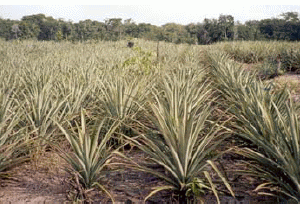 Pineapple
cultivation's yield and therefore the production cost
of one kilogram of pineapple per hectare depends heavily
on how the plantation had been taken care of. Pineapple
cultivation's yield and therefore the production cost
of one kilogram of pineapple per hectare depends heavily
on how the plantation had been taken care of.
Production cost of one kilogram originated from
manual cultivated and rainfed plot is different from
a mechanical and irrigated one. Furthermore, one
hectare plot submitted to good fertilization and
efficient pest control gives the highest yield, which
can go from 40 metric tons of pineapple fruit to up
to 65 metric tons.
Planting is done with suckers / shoots or slips. Drawing
below - courtesy of the National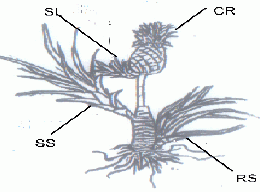 Agricultural Institute of Guyana - shows the positioning
of various planting materials available on pineapple
plant:
Agricultural Institute of Guyana - shows the positioning
of various planting materials available on pineapple
plant:
- Ratoon
shoots
(RS) or suckers are shoots produced
from ground level, which when
used for planting produce fruit
twelve to fourteen months after
planting.
.
- Side
shoots
(SS) or suckers bear fruit after
eighteen to twenty months after
planting.
- Basal
suckers
- also called Slips (SL) -
are located at the base of fruit. They produce fruit
fourteen to sixteen months after planting. They are
the preferred type of planting materials.
Manual cultivation / furrowing / pest control spraying
of a small plot (1 to 5 hectares) could be an advantage
to a small producer if hands are available at affordable
cost.
For plots starting from 5 hectares it is better to
proceed with mechanical cultivation./ furrowing / pest
spraying. The initial expenses to purchasing agriculture
equipment and laying down an efficient irrigation
system will
pay back manifold in higher yield in the range of 40
to 65 metric tons of pineapple fruit per hectare.
In
current issue we consider
a medium size (400 hectares) plantation of pineapple
structured into 10 plots of 40 hectares each, with mechanical
cultivation / furrowing / pest spraying / irrigation
system / plastic laying weed control. Etc. In short
a highly technically organized and managed plantation
in order to producing top quality pineapple fruit, high
yields in the range of 40 to 65 metric tons per hectare
on average.
|

|
French
speaking people
may acquire the excellent
"Pineapple
Producer Work Book"
published by "Les
Nouvelles Editions
Africaines"
titled: "La
culture de l'ananas
d'exportation en
C�te d'Ivoire -
Manuel du planteur",
which provides extensive
and documented explanation
on how to setup
and manage a pineapple
agribusiness in
Africa.. |
|
Click
on above image to read an excellent pineapple
booklet in PDF format produced by the National
Agricultural Institute of Guyana. You may need
Acrobat
Reader
available here.
Right
click
here
and choose
Save As
to download the booklet.
|
-
PRODUCTION COST PER KILOGRAM FOR 400 HECTARES OF PINEAPPLE
PLANTATION ORGANIZED INTO 10 PLOTS OF 40 HECTARES
As explained above, 40 hectares are planted each
month, to be harvested 14 to 16 months later,
in order to having an average
production yield of 50 metric tons of pineapple fruit
per hectare
- under following assumptions in order to reaching
|
-
Mechanical clearing, forking, trenches digging,
furrowing, pest control spraying. Etc.
- Manual
planting,
fertilizer spreading,
-
Plastic layers weeding
and some manual
weeding.
- Additional
irrigation system
to rainfalls
- Regular
utilization of efficient
pest control products.
- Manual
harvesting. Etc. |
Table
below lists investment components over one cycle of
14 months production (for a new entrant producer)
from which the average production cost of one
kilogram of fruit per hectare is calculated
|
PRODUCTION COST
IN US$ PER KILOGRAM AND PER HECTARE
|
|
Yields
- metric tons
|
40
|
45
|
50
|
55
|
60
|
65
|
|
PRODUCTION
EXPENSES / US$ /
hectare
|
|
Hands
|
466
|
466
|
466
|
466
|
466
|
466
|
|
Planting
materials
|
2,018
|
2,018
|
2,018
|
2,018
|
2,018
|
2,018
|
|
Fertilizing
|
1,200
|
1,200
|
1,200
|
1,200
|
1,200
|
1,200
|
|
Pest
control
|
750
|
750
|
750
|
750
|
750
|
750
|
|
Other
chemicals
|
150
|
150
|
150
|
150
|
150
|
150
|
|
Miscellaneous
/small equipment
|
150
|
150
|
150
|
150
|
150
|
150
|
|
Heavy
equipment operation
|
300
|
300
|
300
|
300
|
300
|
300
|
|
Supervision
|
90
|
90
|
90
|
90
|
90
|
90
|
|
Land
charge / hiring
|
25
|
25
|
25
|
25
|
25
|
25
|
|
Total
production costs
off plantation
|
5,149
|
5,149
|
5,149
|
5,149
|
5,149
|
5,149
|
|
OTHER
COSTS / US$ / hectare
|
|
Administration
|
8
|
8
|
8
|
8
|
8
|
8
|
|
Contingencies
(5% of operational
costs)
|
257
|
257
|
257
|
257
|
257
|
257
|
|
Amortization
|
30
|
30
|
30
|
30
|
30
|
30
|
|
Packing
|
1,500
|
1,500
|
1,500
|
1,500
|
1,500
|
1,500
|
|
Interests
on operational expenses
|
771
|
771
|
771
|
771
|
771
|
771
|
|
Total
other costs
|
2,566
|
2,566
|
2,566
|
2,566
|
2,566
|
2,566
|
|
Total
cost of production (ready for transport to harbor)
|
7,715
|
7,715
|
7,715
|
7,715
|
7,715
|
7,715
|
|
Cost
of production per Kg (ready for transport to harbor)
|
.193
|
.171
|
.154
|
.140
|
.129
|
.119
|
As
shown in the last row
of above table it is in the
best interest of the producer
to target the highest possible
yield.
This is achieved by a systematic
selection of suckers / slips
(the heavier suckers / slips' weight, in the range of
400-500 grams, the best for the size and weight of the
fruit); good
balancing of suckers / slips population per hectare
(from 11,000 for one row planting to up to 66, 000-70,000
plants for multiple row planting); regular
and systematic pest control application; additional
irrigation if necessary; systematic weeding.
Etc.
- Interested parties - private African and international investors /
companies, government
agencies,
international development
agencies - to make contact through the Free Access Support Console available at this link
Contact through the support console will get quickest reply from Africabiz Online's staff, than contact by emails. Click here for contact information. Be advised that first contact should be through the support console to be followed by phone calls. If you are a VIP-Member, use VIP-Members Support Console available here.
Before you consult please click
here to review this clarification
|
|

